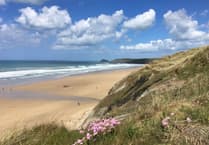NOW, the New Inn is quite a remarkable village pub, not withstanding the amazing clientele (I had to say that, otherwise I can’t go back in).
The original part of the building is believed to date from the 11th century and housed the monks who oversaw the building of the church nearby. The church was built in Norman times, replacing a Saxon church, and was itself replaced in the 15th century. The enormous fireplaces in the pub are believed to be original to the Norman church. At 720 feet above sea level, it’s believed to be the highest pub in Cornwall, giving the beer a unique flavour (so says landlord Darrell).
It does make you realise that you are just a temporary custodian of your seat at the bar (which has been in different locations over the years - not sure what the monks would think of the various drink concoctions we have today) and as you cross the worn threshold, how many thousands have gone before you. There have been tourists who comment it’s a great pub but needs a bigger car park - something the monks obviously didn’t plan for 1,000 years ago.
However, this age pales into insignificance when we consider the oldest tree in Britain. There are three contenders, all yew trees - the Fortingale Yew in Perthshire, the yew at St Cynog in Defynnog and the Crowhurst Yew in Somerset. All are thought to be 2,000 to 3,000 years old, perhaps more. Imagine the sights they have seen. Yew trees are such long lived because of the hard wood, therefore resistant to rot, the slow growth and the ability to renew themselves. It does bring our modest lifespans into some sort of context.
You can read Fred Knobbit’s archive at www.bodminblogger.com





Comments
This article has no comments yet. Be the first to leave a comment.